|
24th-28th
April
Isle of Arran highlights
This is a short account of a recent 5 day break taken by my wife and me
on the wonderful Isle of
Arran in the Firth of Clyde. Below are highlights
of the many photos I took in locations
around the island.
The
ferry journeys between Ardrossan to Brodick are always exciting. These
are usually spent on deck scanning the water for passing birds and
sometimes Cetaceans such
as Dolphins, Porpoises and even Orcas are possible. As the ferry left
Ardrossan on Wednesday 24/4, some Eider and Black Guillemots were each
socially active. Further out we encountered a few Common Guillemots and
a couple of Manx Shearwaters, but that was it. It was a relatively
quiet crossing.
| Eider |
Black Guillimont |
Common Guillimot |
Manx Shearwater |
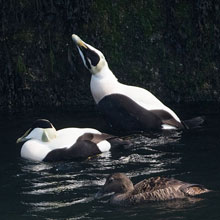 |
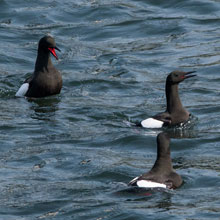 |
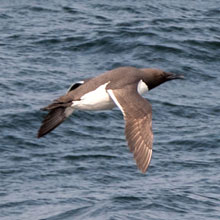 |
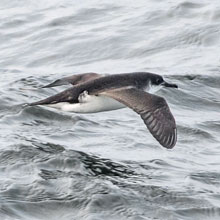 |
On the next day,
Thursday 25/4, we explored the coast
from Lamlash to Clauchlands Point. The tide was low and the sun was
over the shoreline making it tricky to photograph in that direction.
However, I came across a few interesting passerines
and the Common Seals were nice to see. A fine Song Thrush was cautiously
searching for invertebrates on the lawn of one of the houses that lined
the route. On trees just before the Arran Outdoor Centre I came across
a singing Willow Warbler, and opposite the Centre I noticed a male
Linnet that was uncharacteristically calm as it sat on a branch as I
approached to take its photo.
| Common Seal |
Song Thrush |
Willow Warbler |
Linnet |
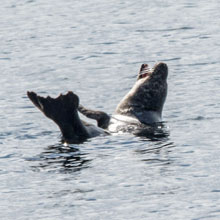 |
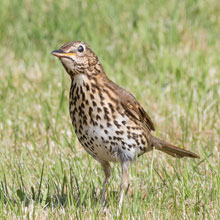 |
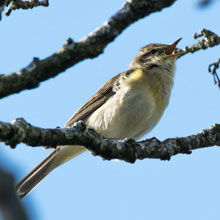 |
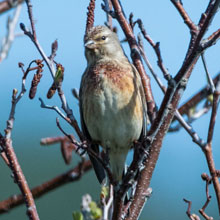 |
View across Lamlash Bay
from the Arran Outdoor Centre:
On an adjacent bush I
heard the unmistakable song of the Sedge
Warbler .
Eventually I got a few decent shots when it made its way up to the top
branches. In a field a bit further down the road I got a pleasing flight
shot of a Hooded Crow moving between the cattle. I captured a quick
snap of pair of mating Chaffinches but I had a bit longer to get a photo
of a Garden
Tiger Moth
caterpillar crossing the road.
| Sedge Warbler |
Hooded Crow |
Chaffinch |
Garden Tiger Moth Caterpillar |
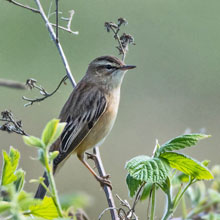 |
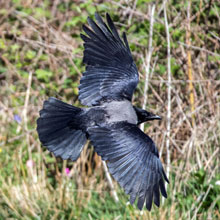 |
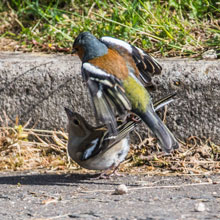 |
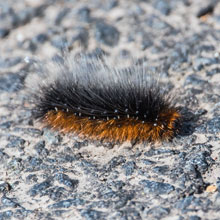 |
In
the afternoon I stopped near Corrie at a picnic spot overlooking the
sea. The weather had dulled but a few birds were active on fresh piles
of seaweed. Of most interest were several Common
Sandpipers
feeding there but who, every so often, would fly several metres towards
each other while making a high lingering call. I also got a flight shot
of a passing Red breasted Merganser. On the seaweed I saw a
wee Meadow
Pipit hopping between rocks and also a White Wagtail.
| Common Sandpiper |
Red-breasted Merganser |
Meadow Pipit |
White Wagtail |
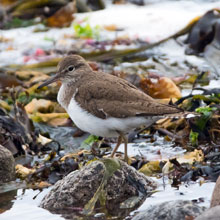 |
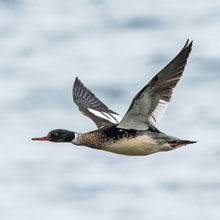 |
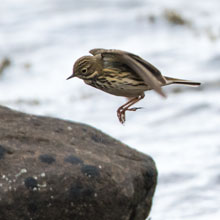 |
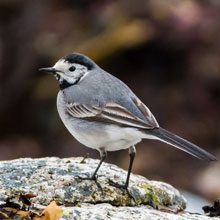 |
With
rain predicted on Friday 26/4 we planned a drive from Brodick to
Lochranza and back. The first stop was along the north side of Machrie
Moor after I spotted a distant Hen
Harrier on its swooping
passage
across the Moor. I hurriedly, and safely, parked the car and readied my
camera by which time the Harrier had got a wee bit closer. Sadly though
it disappeared over a ridge and that was that. The next sighting was a
bit further along the road where a big cock Pheasant was getting over
an attack of what looked like a female Hen Harrier on his family of Hen
and chicks. The whole lot scattered leaving the cock wandering the field
crowing pathetically. The next encounter was near Pirnmill where a pair
of exotic Peacocks were wandering out into the middle of the road. They
had most likely escaped through an unsecured gate from one of the
houses along the road. Just before Pirnmill I saw a small flock of
Red-breasted Mergansers swimming near the shore.
| Hen Harrier |
Pheasant |
Peacock |
Red-breasted Merganser |
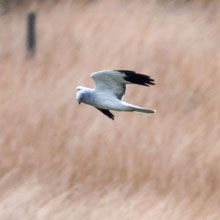 |
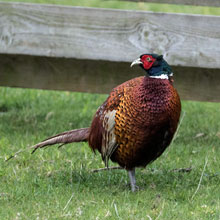 |
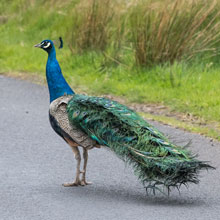 |
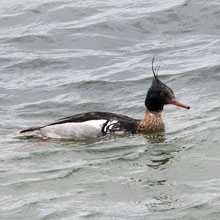 |
The
rain was a very annoying drizzle when we entered Lochranza and apart
from a close shot of a Jackdaw and a juvenile Herring Gull, it was a
wash-out. We made our way back to Brodick without any further
sightings. During a brief sunny interval I snapped a male Pied Wagtail
and a vociferous Herring Gull.
| Jackdaw |
1st Cycle Herring Gull |
Pied Wagtail |
Herring Gull |
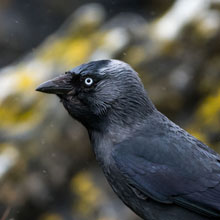 |
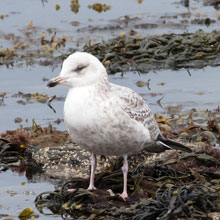 |
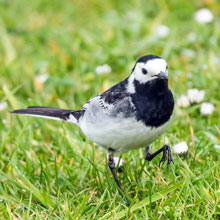 |
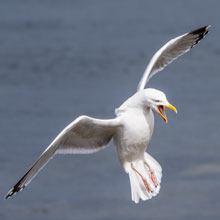 |
We drove further south into Lamlash where I
spent a very enjoyable hour photographing a pair of Gannets
diving just off the pier into Lamlash Bay. Impressive birds! They were
probably from Ailsa Craig, about 10 miles to the south (See
also,
“Pictures of the Week”, below).
On
Saturday 27/4 we drove around the south of Arran and stopped briefly at
Blackwaterfoot. It was another wet day but we were lucky to catch the
sun as I explored the coast south of the Hotel. I got some nice shots
of a very accommodating Rock Pipit. There was a small colony of Common
Seals on rocks just offshore (See also, “Pictures of the
Week”, below).
By the rough shore road i heard the melodious call of a Dunnock
and found it only a couple of metres away on a small bush (See also,
“Pictures of the Week”, below). As I returned to
the car I noticed a
few Ringed Plover on the shore picking their way over the seaweed.
| Rock Pipit |
Grey Seal |
Dunnock |
Ringed Plover |
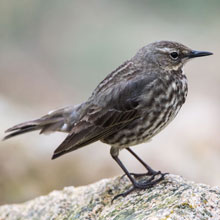 |
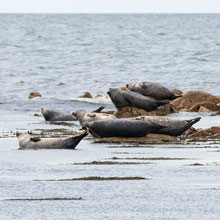 |
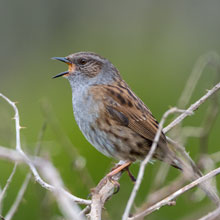 |
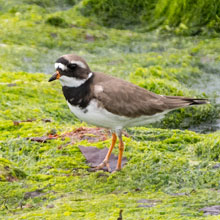 |
Later
that day, after a few coffee shops, I returned to the Corrie car park
hoping to get some more shots of the antics of the Common Sandpipers.
Dog walkers put paid to that idea but rather unexpectedly as I sat in
the car bemoaning the poor weather and poorly behaved dog walkers, a
Sparrowhawk landed on the edge of the car park a couple of metres from
the drivers seat. Without opening the window I hastily snapped the
couple of shots shown below. It flew off as I took the second shot
through the raindrop-covered car window. An exciting moment.
|
Sparrowhawk |
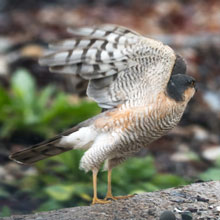 |
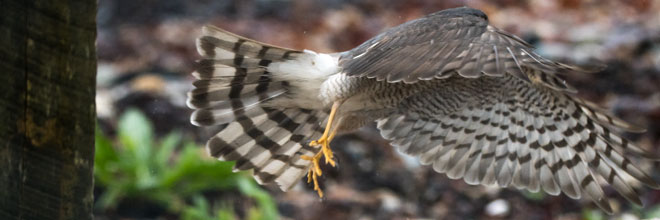 |
On
Sunday 28/4, we were scheduled to return home but since the weather had
improved considerably, we squeezed in a quick visit to Machrie Moor,
famous for its ancient stone
circles .
From the car park there is a 100m walk across a sheep’s field.
Many of
the sheep had young lambs. Beyond the field there was a further 400m to
walk to reach the main area of circles. Alas we didn’t come
across many
birds on the way. I did glimpse another Hen Harrier, but way too
distant for a good shot. The Stone Circles are fascinating,
connecting
present day peoples with those of Neolithic and Early Bronze Ages. On
the way back to the car I was rather more fortunate to come across an
impressive Skylark, first hovering high in the air rapidly repeating its
familiar tones
before descending onto a Gorse bush only metres away (See also,
“Pictures of the Week”, below). I had similar luck
soon after when I
heard the equally-familiar song of a Willow
Warbler, just as I passed
through a gate.
| Sheep |
Stone Circles |
Skylark |
Willow Warbler |
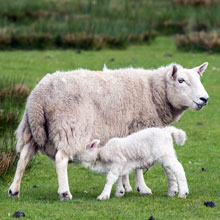 |
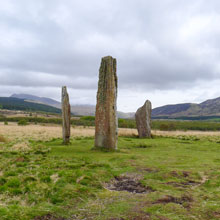 |
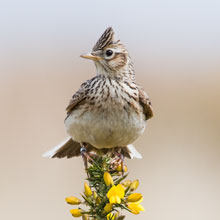 |
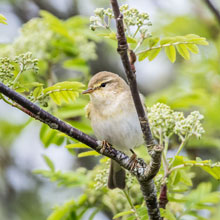 |
We
returned to the Mainland just as the weather once again took a turned
for the worse. The crossing didn’t yield much of interest in
the way of
birds, or Cetaceans for that matter. I didn’t mind though as
I was more
than happy with my collection of shots, despite the inclement weather.
I always enjoy Arran and I’m sure it won’t be too
long before I return
there for another break.
Pictures of the Week:
| Gannet |
Common Seal |
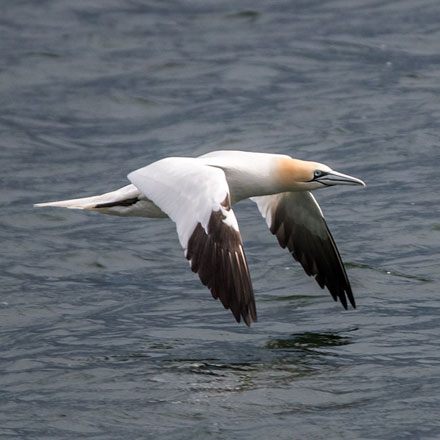 |
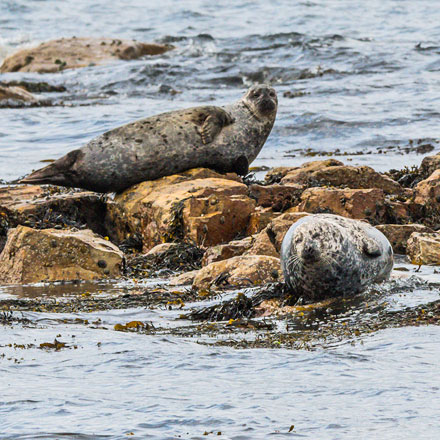 |
| Dunnock |
Skylark |
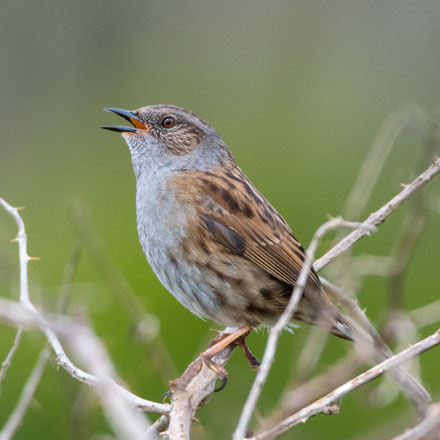 |
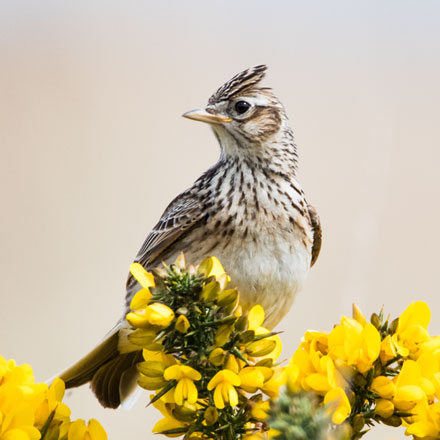 |
21st April 2019:
Hogganfield Park LNR
John was on family
Easter duties, as was I, but I sneaked out before lunch and visited Hogganfield
Loch,
Glasgow (but no breakfast this week as I was “on the
clock”). The weather was ideal - warm, calm and bright. I
decided
to do a simple circuit of the Reserve to see what I could come up with.
Right at the car park, where a worker had just emptied a sack of seed
into the Loch, I was surprised to see that not all of the wintering Whooper
Swans
had returned home as there was a single Whooper feeding with the flock
of Mute Swans. Maybe it has an injury. On the platform, a pair of
female Goosanders were having a disagreement with a Lesser Black-backed
Gull. The Black-headed Gulls were also very active.
| Whooper Swan |
Female Goosander |
Lesser Black-backed Gull |
Black-headed Gull |
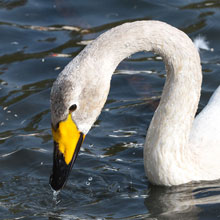 |
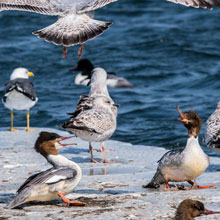 |
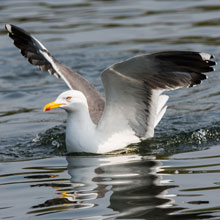 |
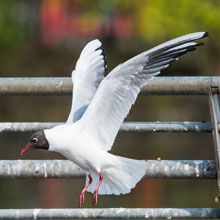 |
I passed a Great Crested
Grebe and watched it make repeated dives for
fish, but it drifted further away. From previous recent visits I know
there were at least 3 pairs around the Loch. Usually there is one pair
that successfully produce chicks. A brightly-marked Peacock
butterfly landed
near me, and soon after I noticed a male Orange
Tip butterfly on
a Cuckoo Flower. There were also patches of Siberian
Squill by the Loch side.
| Great Crested Grebe |
Peacock Butterfly |
Orange Tip |
Siberian Squill |
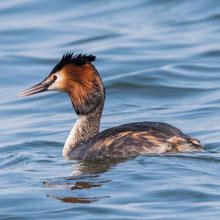 |
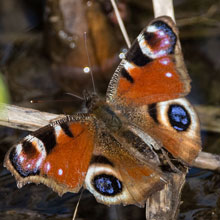 |
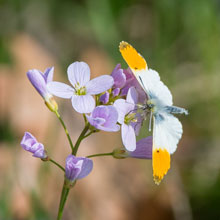 |
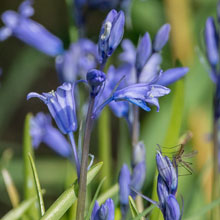 |
At the south-east corner
of the island a few water
birds
were active, mainly Mallard, Coot and Moorhen. Occasionally one of the
many Grey Herons that were nesting on the island (we could call it a
heronry) flew dramatically overhead.
| Drake Mallard |
Coot |
Moorhen |
Grey Heron |
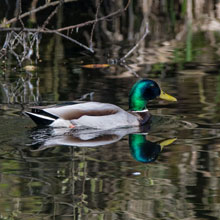 |
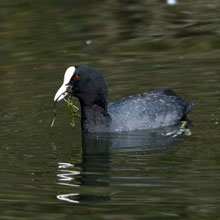 |
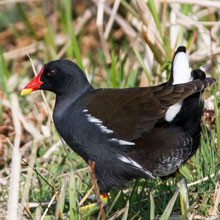 |
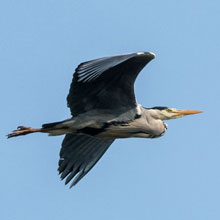 |
A Grey Heron stood
prominently high in the trees, maybe waiting on its
mate to return. The Sycamores that line the Park road in that area
house many birds, some of which I managed to photograph - a pair of finches namely a rasping Greenfinch and
male Bullfinch, and a pair of restless Long-tailed
Tits .
| Grey Heron |
Greenfinch |
Bullfinch |
Long-tailed Tit |
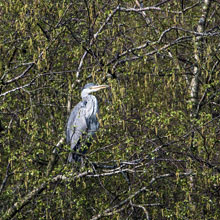 |
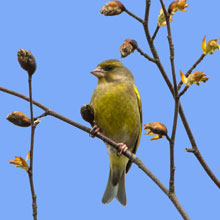 |
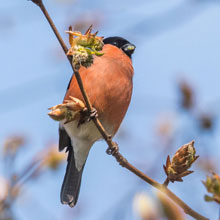 |
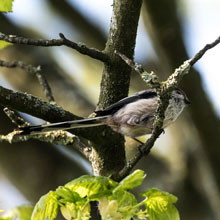 |
I continued my circuit
by following the rough path towards the exit to
Avenue End Road. That took me past a pond that often holds some
interesting birds. I saw a Canada Goose floating motionless mid-pond. On
the opposite side, a Heron emerged from the reeds to probe the
water’s edge for tasty morsels such as fish, frogs,
newts. A
pair of Gadwall drifted across the water. In the area just east of the
pond a pair of buck Roe
Deer saw me and
legged it just as I saw them (see also “Pictures of the
Week”, below).
| Canada Goose |
Grey Heron |
Gadwall |
Roe Deer |
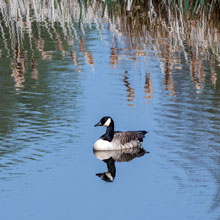 |
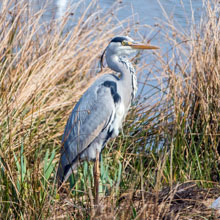 |
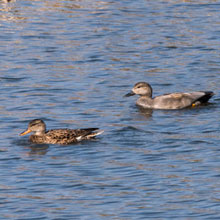 |
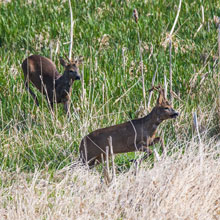 |
In the bushes behind me
I heard the descending tones of Willow
Warblers (see
also “Pictures of the Week”, below). I managed to
get some
decent shots. I also snapped a few shots of a Whitethroat. As I rested
on some wooden seats, a Goldfinch appeared on top of a tall bush in
front of me. A Magpie flew past just as I passed out of the Park.
| Willow Warbler |
Whitethroat |
Goldfinch |
Magpie |
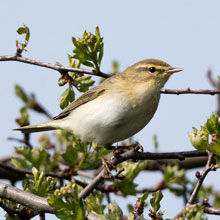 |
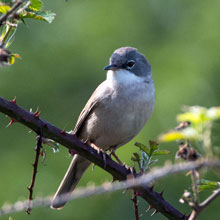 |
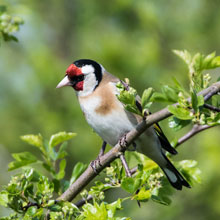 |
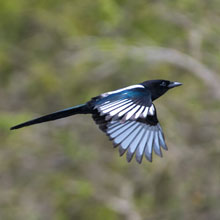 |
I walked the short
distance to the other park entrance. On the way I came across a group
of Field
Horsetail standing
proudly amid some fly-tipped rubbish. Also there was a lovely Yellow
Archangel plant. Some
pretty Field Speedwell and Forget-me-nots also brightened an otherwise
depressing sight.
| Field Horsetail |
Yellow Archangel |
Field Speedwell |
Forget-me-Not |
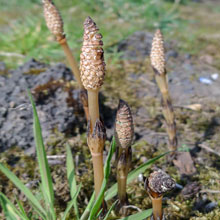 |
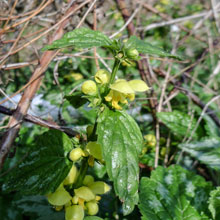 |
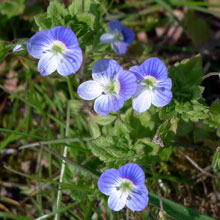 |
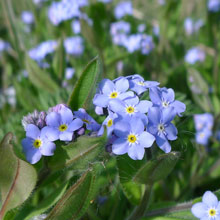 |
After snapping some
smart-looking Dandelions, I re-entered the Park. A
Chaffinch was singing on a high branch. A Kestrel loomed midway up
another more distant tree. I eventually rejoined the main Park road
where I noticed a nesting Mute Swan. I watched a Great Crested Grebe as
she attempted to build a nest. She soon moved away after being
disturbed by a large dog.
| Dandelion |
Kestrel |
Mute Swan |
Great Crested Grebe |
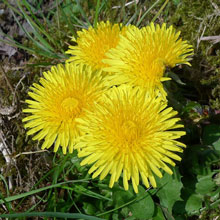 |
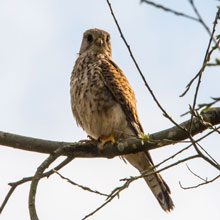 |
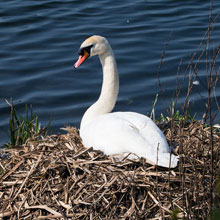 |
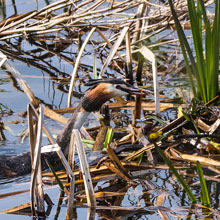 |
View of the Loch from the east end of the
Park. It shows BioHaven
artificial islands, installed with the aim of cleansing the water. The
picture shows a Mute Swan, Grey Heron, Tufted Ducks and passing
Goosanders, as well as large patches of Marsh Marigold.
The Grebe attempted a
return to its would-be nest, with a huge stick in
its beak, only to find its path to its preferred site too narrow to move
the stick through. A pair of Greylags weren’t making her task
any
easier (see “Pictures of the Week”, below). As I
neared the
end of my circuit I managed a photograph of a male Blackbird with its
beak stuffed with worms. I also came across an attractive enclave of
Common Chickweed at the base of a tree.
| Great Crested Grebe |
Blackbird |
Common Chickweed |
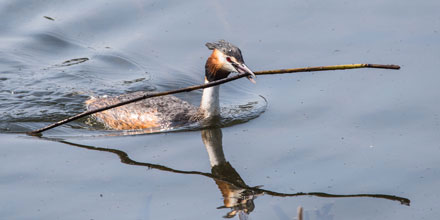 |
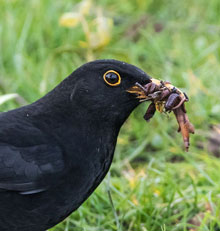 |
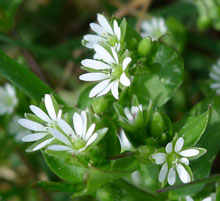 |
As you can see above,
the Hogganfield Park LNR is a great place to
commune with nature. It is surprising to find such close access to a
wide variety of plants and animals in a busy public park. If
you’ve not visited the Park then you now know what
you’re
missing.
Pictures of the Week:
| Roe Deer |
Chaffinch |
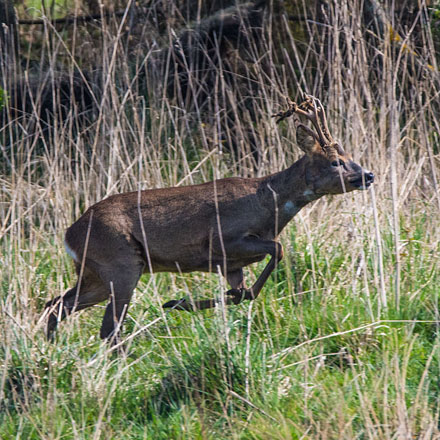 |
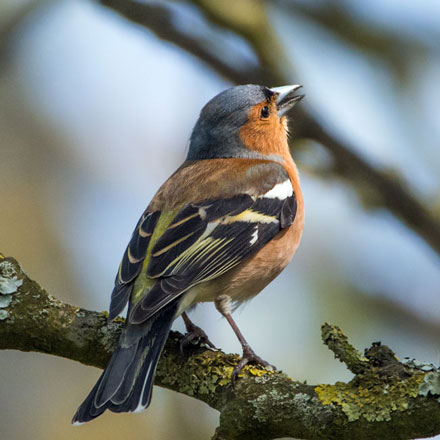 |
| Willow Warbler |
Greylag Goose |
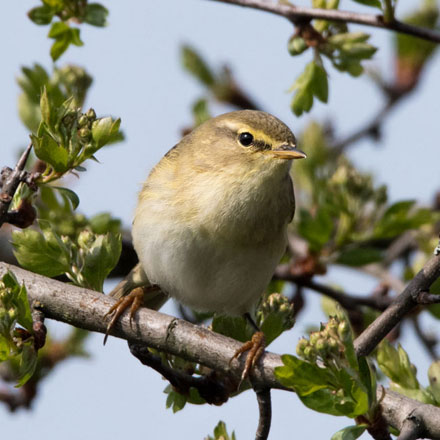 |
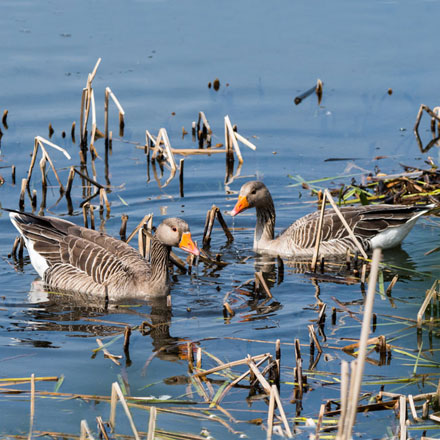 |
14th April 2019:
Portmoak Moss and RSPB Loch Leven
I had a conversation in
midweek with a birder I met at Lochwinnoch, who
advised me that if I wanted to see Green Woodpeckers then a good place
to go would be Portmoak Moss at Scotlandwell. So I thought
I’d
check it out and also have a long overdue visit to the neighbouring
RSPB Loch Leven (formerly Vane Farm). The weather was to be mainly
cloudy with a chance of the odd sunny interval. We called in at
Bathgate Morrisons for breakfast (super food and service, with only a
slight grumble of over- cooked tattie scone: 9.5/10) then it was across
the Queensferry
Crossing to bonny Loch
Leven. The Portmoak
Moss Reserve is owned by
the Woodland Trust and there is an active Community Woodland
Group
. Once parked we made our way around the reserve’s circular
route. We came across a large area of Butterbur by a pathside ditch.
Their flowering spikes sat in a bed of Opposite-leaved Golden Saxifrage.
There was also a large Green Alkanet plant in flower.
| Common |
Butterbur |
Opposite-leaved Golden Saxifrage |
Green Alkanet |
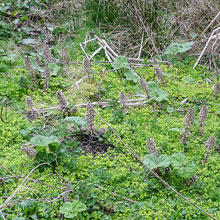 |
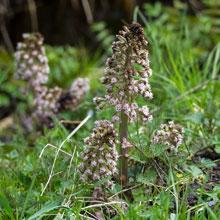 |
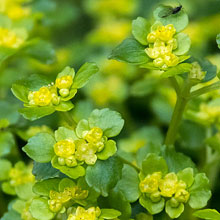 |
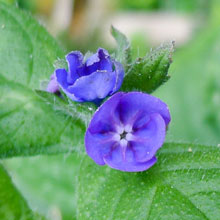 |
I was pleased to see an
Early Bumblebee feeding on a Butterbur spike. Their comparatively small
size and yellow and orange colourings make them fairly easy to
identify. As we pressed on, we noticed that many of the tree trunks
carried fungi, such as the Hoof Fungus shown below. It was used
forthousands of years as a source on tinder. Eventually we emerged from the woods out
into the open area central to the reserve. This was the Portmoak Moss,
a raised peat bog , the predominant plant in the
area being Sphagnum Moss
(commonly called Peat Moss). A lone Roe Deer stood cautiously at the
edge of the woods watching us carefully. It looked as if it was casting
its coat as it was pretty shabby.
| Early Bumblebee |
Hoof Fungus |
Sphagnum Moss |
Roe Deer |
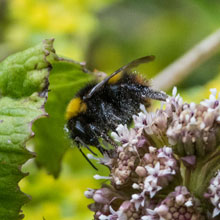 |
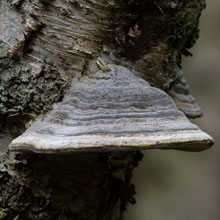 |
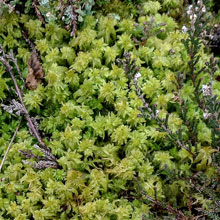 |
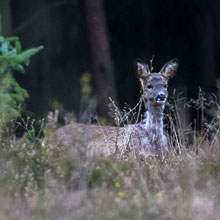 |
Throughout the visit
gliders were circling silently overhead. These were from the local Scottish
Gliding Centre .
We then entered the next area
of woods where we were tantalised by the unmistakable call of a Green
Woodpecker .
However, despite scanning the area for over an hour, it didn’t show. The only
bird I was able to photograph
was a Chaffinch close to the car. As we drove out of Scotlandwell we did
also see a gathering
of Swans feeding in the middle of a field. These were mainly Mute Swans
with a few Whoopers.
|
Chaffinch |
Mute Swan |
Whooper Swan |
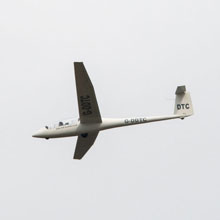 |
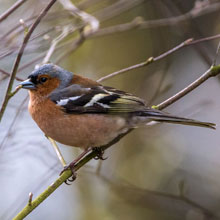 |
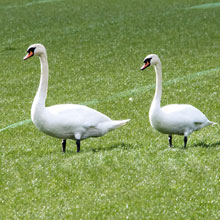 |
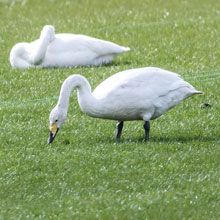 |
We drove the few miles
south to RSPB
Loch Leven Reserve
and we were soon sitting in the Gillman hide where I was relieved to
find some birds to
photograph. A Moorhen was prowling below a feeder. Then some
Greenfinches appeared followed by a pair of Tree Sparrows. A bold wee Coal Tit sped in, nabbed a seed
and sped out, in one movement.
| Moorhen |
Greenfinch |
Tree Sparrow |
Coal Tit |
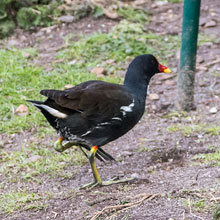 |
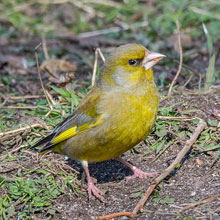 |
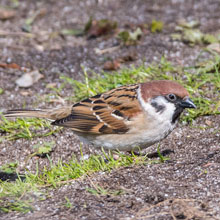 |
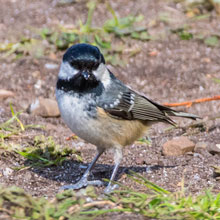 |
A Blue Tit, Robin and
Goldfinch (see “Pictures of the Week”,
below) were other participants in the feeding frenzy. In the reeds by
the pond a Mallard sat
preening but there was little else on the pond, but
further away from the hide, over the south end of Loch Leven, I could
just make out the
movements of groups of Tufted Ducks and Goldeneye.
| Blue Tit |
Drake Mallard |
Tufted Duck |
Goldeneye |
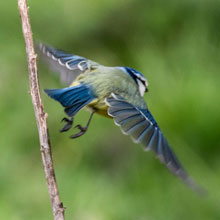 |
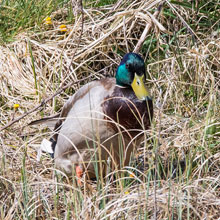 |
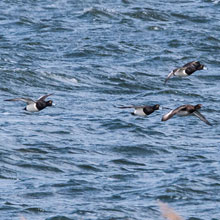 |
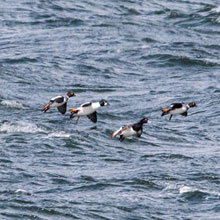 |
The view of the hills
east of Loch Leven, taken from the Carden Hide:
We moved directly to the
furthest hide, the Carden Hide, as we had been
tipped off that a Shoveler was showing well there. Of course when we arrived at the hide another birder
informed us that it had flown back
to where we’d just left. However, there were lots of birds on
the pond, including a
pair of lovely Shelduck. A half a dozen Greylags were
also on the water. Prominent, facing the hide, were a colony of nesting Black-headed Gulls on a fenced-off
island. Occasionally some of
these gulls took to the air and noisily circled the island, protesting at some perceived threat (see
“Pictures of the Week”,
below). A notice carried the information that chicks were expected
imminently. In an
adjacent field a large cow was watching its calf as the commotion played
out.
| Shelduck |
Greylag Goose |
Black-headed Gull |
Calf |
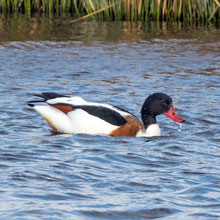 |
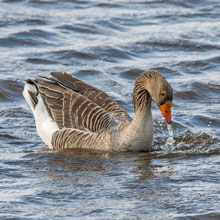 |
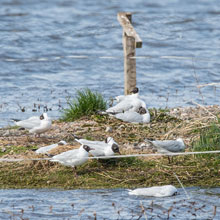 |
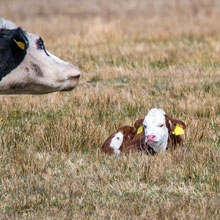 |
Just beyond the island
of gulls I spotted a Little Grebe diving for
small fish. Around it a few Tufted Ducks moved across the pond.
John had spotted some Lapwings flying near to the Calf and very
luckily for us it landed very close to the hide, well illuminated and unaware of our attention (see
“Pictures of the Week”,
below). It was a very handsome bird with its fine crest and beautifully
iridescent wing
feathers. Just as we left the Carden Hide, a pair of Shelduck flew in an
landed to the west of the hide.
| Little Grebe |
Tufted Duck |
Lapwing |
Shelduck |
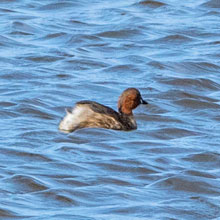 |
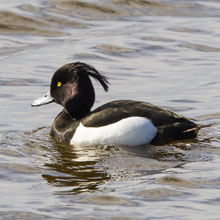 |
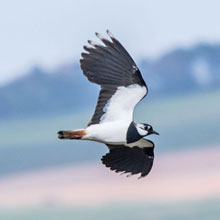 |
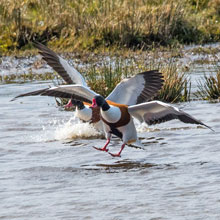 |
We walked back to the
hide we missed, the Waterston Hide, and immediately we could see a
couple of pairs of Teal dabbling in the pond. The fine plumage of the drakes, especially
the green head streak, never
fails to impress. A small flock of Meadow Pipits were active in the grass around the hide, although they
were hard to pick out with the
naked eye, never mind with the camera. On our walk back, between the Gillman and Waterston, from
through a wooden viewing fence, we got close views of a Little
Egret . These are
no longer a rarity in
Southern and Central Scotland so they no longer create as
much excitement in birders here as once the did. My final capture was of a fine Primrose just
outside the Gillman Hide. It is one of the earliest flowers to appear in
spring, hence the name “Prima Rosa”, first rose (although it’s not a
rose).
| Teal |
Meadow Pipit |
Little Egret |
Primrose |
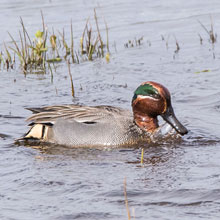 |
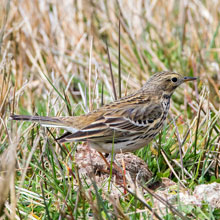 |
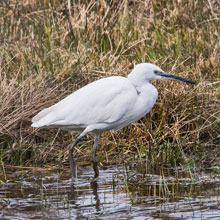 |
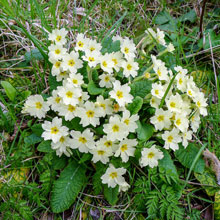 |
Well, we
didn’t get to see a Green Woodpecker, although we did
hear them, but it was good to familiarise ourselves with the Portmoak
Moss Reserve. We will no doubt return there and we may yet catch sight
of one of their Green Woodpeckers. One other regret is that we missed
seeing a Spoonbill that was reported just as we had to leave. Oh well,
that’s how the cookie crumbles - talking of which, our usual
end-of-visit tea and Danish pastries went down as well as ever. We
always finish on a high.
Pictures of the Week:
| Goldfinch |
Robin |
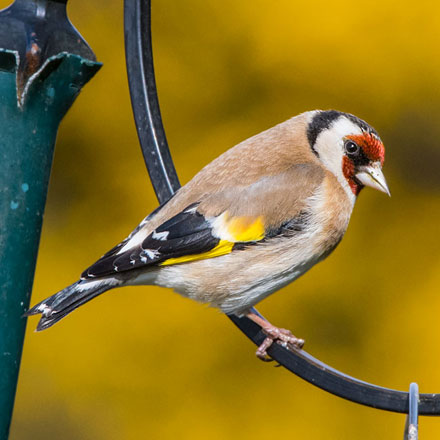 |
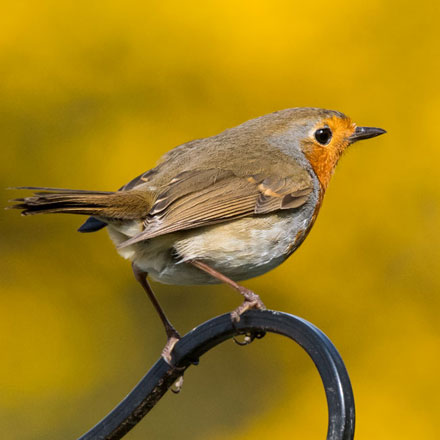 |
| Black-headed Gull |
Lapwing |
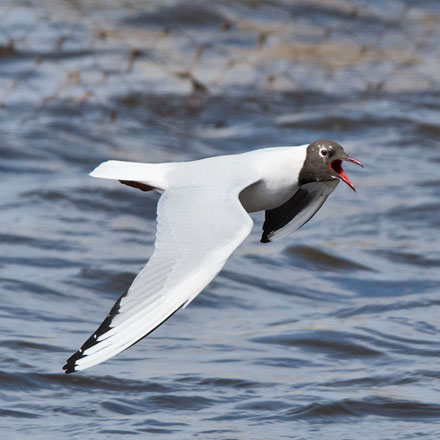 |
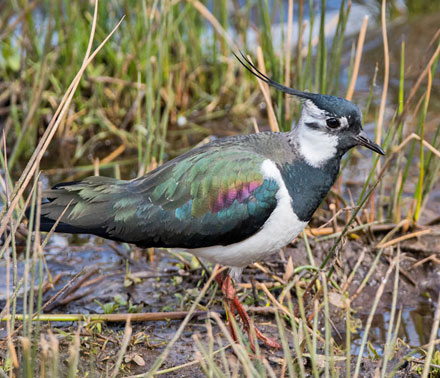 |
7th April 2019:
Troon and
Irvine
Harbour
Sunday's weather
for Scotland was to be overcast with the best
chances of brightness in the west. I thought I'd give Troon a try as
I'd heard there were Purple Sandpipers there. After last
week's poor brekky in Kilmarnock Asda we thought we'd start
the day with breakfasts in Stewartfield Morrisons, East Kilbride (9/10:
slow service in poor lighting). It was indeed overcast when we
arrived at the South Beach Esplanade Car Park in Troon. As we walked
onto the beach, a Royal
Navy Hawk T1aflew over our heads as it came into land at
Prestwick. It was the first of many frequent passes, leaving us to
believe these were training flights. Despite the gloomy conditions the
beach was overrun with dog walkers,however we quickly came across a
lovely pair ofStonechats;
(also see Pictures of the Week, below). Another Prestwickbound
aeroplane passed overhead, a yellow air
ambulance, a
Beech
King Air 200C
| Royal Navy Hawk T1a |
Male Stonechat |
Female Stonechat |
Beech King Air 200 C |
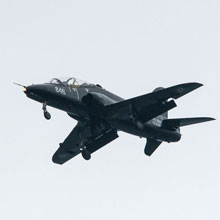 |
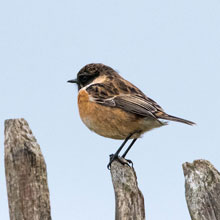 |
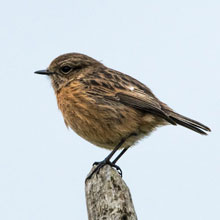 |
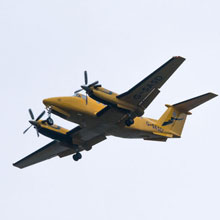 |
We made our way towards Meikle Craigs,
moving parallel to the world famous and bird-aware; Royal Troon Golf Course. We saw
our first pair of Sandwich
Terns
for 2019. They didn't hang about and I was lucky too get a
quick
snap. Much closer was a Carrion Crow skimming the salt pools. A pair of
Curlew loitered on the shoreline seemingly tolerating passersby, even
dog walkers. John pointed out a distant, dense flock passing over the west end of Meikle Craigs. I would guess
that they were oystercatchers,
but the picture doesn't help much.
| Sandwich Tern |
Carrion Crow |
Curlew |
Flock |
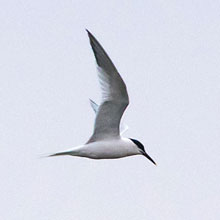 |
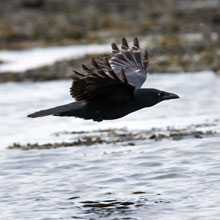 |
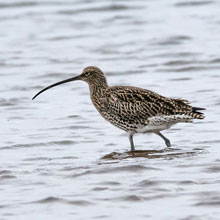 |
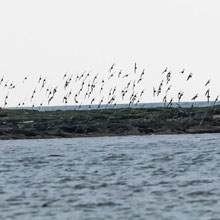 |
An attractive 3rd-year
Herring Gull caught my eye as it flew past. Gulls take 4 years to reach
maturity so ageing
them can be tricky. Offshore there
was a small fishing boat, probably
after lobsters. Sadly there wasn't much more to be seen on
Meikle
Craig. As we returned to the car we did see a small flock of twittering
Linnets that descended onto rotting seaweed on the beach in front of
us. At the car a handsome large Lesser
Black-backed Gull was standing
atop a street lamp (also see Pictures of the
Week, below).
| 3rd Cycle Herring Gull |
Lobster Boat |
Linnet |
Lesser Blacked-backed Gull |
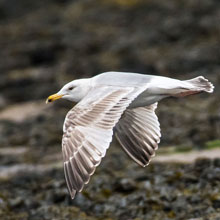 |
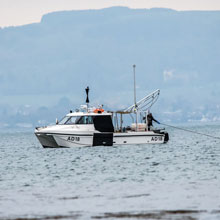 |
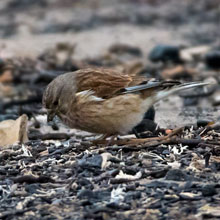 |
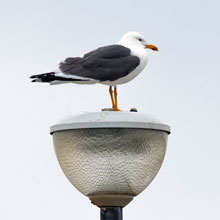 |
We drove the short
distance to the Troon Harbour car park. John noticed
a Rock Pipit preening on the rocks near the car. Also on the same area I spotted a Wren moving unpredictably between the
rocks. We decided to walk south along the Ballast
Bank
to scan the shore for Purple Sandpipers. There were the usual Redshanks
foraging there, and John delighted in his sighting of Sammy
Seal or Grey Seal, as others refer to it.
| Rock Pipit |
Wren |
Redshank |
Grey Seal |
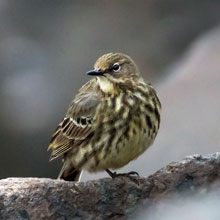 |
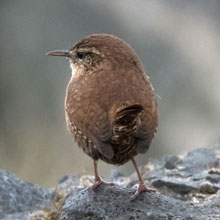 |
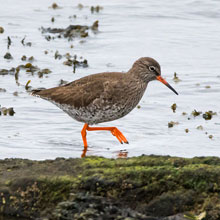 |
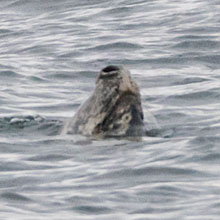 |
Just before the concrete
ramp there were lots of just-blooming plants
of Hoary Cress. We had just reached the Ballast Bank when I got a nice
flight shot of a large
passing Cormorant. I also got a close shot of a
fit-looking adult Herring Gull. Then, to our delight, there they were
foraging, 15m in front
of us, a half dozen Purple
Sandpipers (also
see Pictures of the Week;, below).
| Hoary Cress |
Cormorant |
Herring Gull |
Purple Sandpiper |
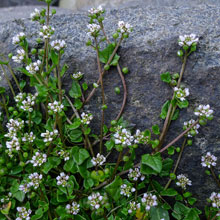 |
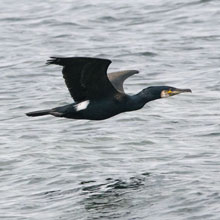 |
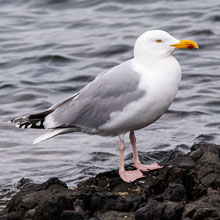 |
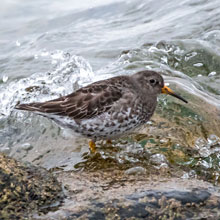 |
The light was poor but I
got some decent pictures nevertheless. We
trooped back satisfied towards the car. John noticed a pair of Black
Guillemots far
offshore. I managed a record shot. I also got shots of a
passing Gannet and a drake Eider.
| Purple Sandpiper |
Black Guillemot |
Gannet |
Drake Eider |
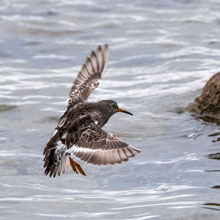 |
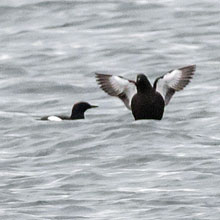 |
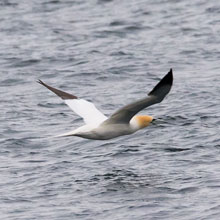 |
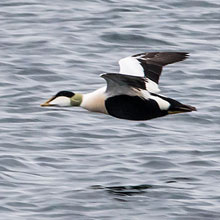 |
A wee male Pied Wagtail
landed on a picnic bench in front of me. John directed my attention to
a fairly large flock of Ringed
Plovers
that had flown onto the
rocks (see also the panorama below). Just beyond
them a pair of Seals had surfaced, and as we left a female House
Sparrow bid us farewell from
a nearby rooftop.
| Pied Wagtail |
Ringed Plover |
Grey Seal |
Female House Sparrow |
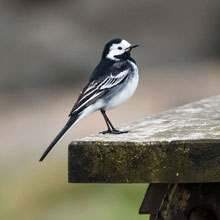 |
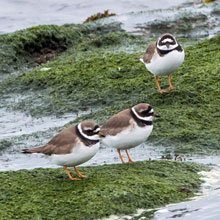 |
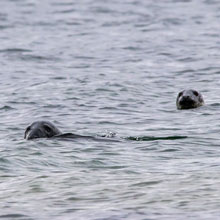 |
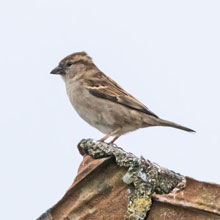 |
A view of the flock of
Ringed Plovers:
We drove the few miles
north to Irvine Harbour, this time seeking
Sandwich Terns that had recently been reported. The scene that greeted
us as we arrived was
unexpected - there was some sort of kite
convention going on. The kites were unconventional, my favourite being
the big purple teddy.
As we walked along the side of the riverside I
captured nice pictures of a fishing Shag and a Great Black-backed Gull.
We scanned the river
mouth for Terns but managed only to see some
passing Red-breasted Mergansers.
| Wonderful Kites |
Shag |
Great Black-backed Gull |
Red-breasted Mergansers |
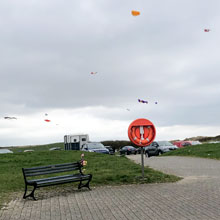 |
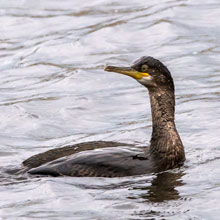 |
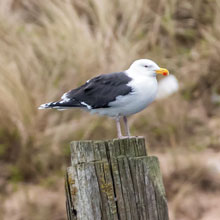 |
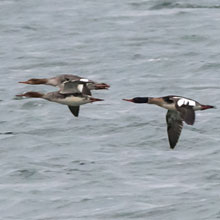 |
Almost at the point of
giving up I detected the familiar
“creaking” call of the Sandwich Tern. Before too
long a
half dozen birds appeared, each diving in the water and sometimes
emerging with fish in their beaks. (also see “Pictures of the
Week”, below)
It had been one of those
days when one might have taken a look out the
window and decided to go back to bed. But the trip had been rewarding
having seen such a
variety of species. Of course we celebrated by
consuming tea and very fine Danish pastries. Nothing ventured, nothing
gained.
Pictures of the Week:
| Stonechat |
Purple Sandpiper |
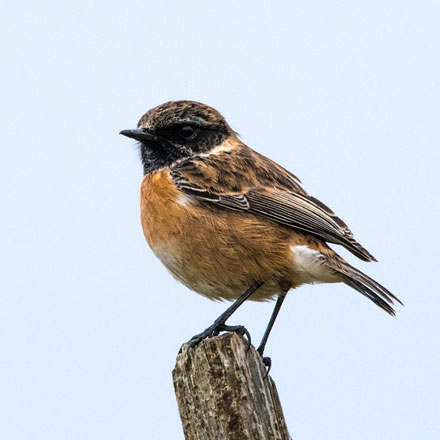 |
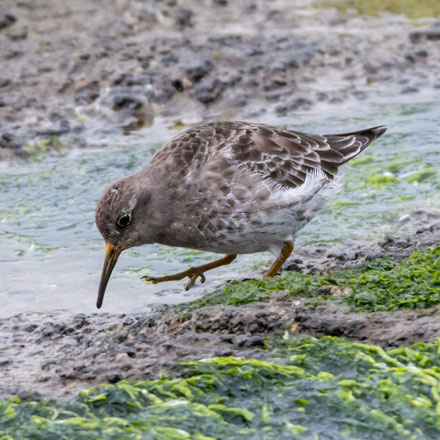 |
| Lesser Black-backed Gull |
Sandwich Tern |
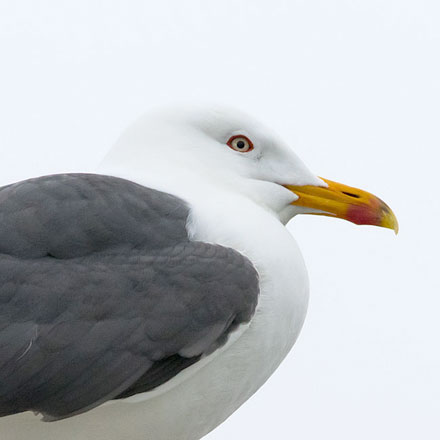 |
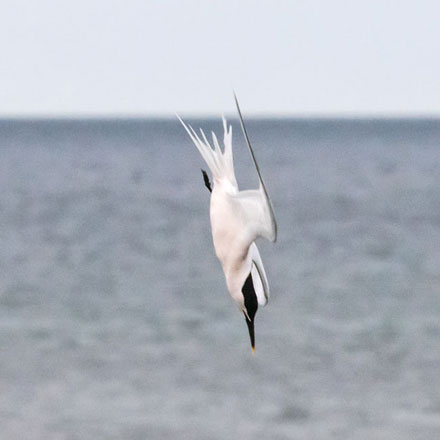 |
Back To Top
|

